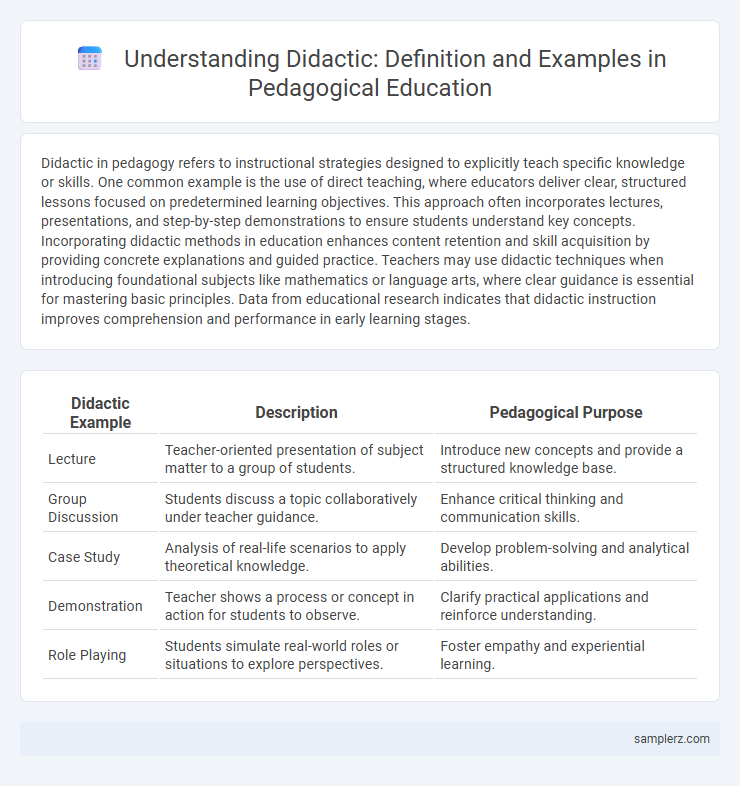Didactic in pedagogy refers to instructional strategies designed to explicitly teach specific knowledge or skills. One common example is the use of direct teaching, where educators deliver clear, structured lessons focused on predetermined learning objectives. This approach often incorporates lectures, presentations, and step-by-step demonstrations to ensure students understand key concepts. Incorporating didactic methods in education enhances content retention and skill acquisition by providing concrete explanations and guided practice. Teachers may use didactic techniques when introducing foundational subjects like mathematics or language arts, where clear guidance is essential for mastering basic principles. Data from educational research indicates that didactic instruction improves comprehension and performance in early learning stages.
Table of Comparison
| Didactic Example | Description | Pedagogical Purpose |
|---|---|---|
| Lecture | Teacher-oriented presentation of subject matter to a group of students. | Introduce new concepts and provide a structured knowledge base. |
| Group Discussion | Students discuss a topic collaboratively under teacher guidance. | Enhance critical thinking and communication skills. |
| Case Study | Analysis of real-life scenarios to apply theoretical knowledge. | Develop problem-solving and analytical abilities. |
| Demonstration | Teacher shows a process or concept in action for students to observe. | Clarify practical applications and reinforce understanding. |
| Role Playing | Students simulate real-world roles or situations to explore perspectives. | Foster empathy and experiential learning. |
Understanding Didactic Approaches in Education
Didactic approaches in education emphasize structured teaching methods designed to facilitate student learning through clear objectives, systematic content delivery, and active teacher guidance. Examples include direct instruction, where educators present material explicitly, and inquiry-based learning, which encourages students to explore and construct knowledge independently. These methods optimize comprehension and retention, aligning instructional strategies with diverse learner needs and educational goals.
Key Principles of Didactic Teaching
Key principles of didactic teaching in pedagogy emphasize structured content delivery, clarity of objectives, and active engagement with learners to enhance comprehension and retention. Effective didactic methods incorporate repetition, feedback, and scaffolded instruction to support progressive learning. Pedagogues apply these principles to develop lesson plans that balance theoretical knowledge with practical application, ensuring measurable educational outcomes.
Classic Examples of Didactic Methods in the Classroom
Classic examples of didactic methods in pedagogy include direct instruction, where teachers deliver clear, structured lessons aimed at specific learning objectives, and the use of repetition and drill exercises to reinforce knowledge retention. Storytelling and analogies serve as effective didactic tools to simplify complex concepts and engage students' critical thinking. These methods emphasize teacher-led communication, aiming to convey information efficiently while establishing a strong foundational understanding.
Role of Lecturing as a Didactic Technique
Lecturing serves as a fundamental didactic technique in pedagogy by enabling educators to deliver organized knowledge efficiently to large groups of students. This approach facilitates the clear presentation of complex concepts and the systematic progression of curriculum content, enhancing comprehension and retention. Effective lecturing incorporates visual aids and interactive questioning to maintain student engagement and support diverse learning styles.
Implementing Direct Instruction in Modern Pedagogy
Implementing Direct Instruction in modern pedagogy involves structured lesson plans with clear objectives and scripted teaching methods to enhance student engagement and retention. This approach emphasizes explicit teaching techniques, frequent assessments, and immediate feedback to ensure mastery of concepts. Research shows that Direct Instruction significantly improves academic achievement, particularly in literacy and numeracy skills across diverse classroom settings.
Real-World Case Studies of Didactic Practices
Real-world case studies of didactic practices in pedagogy highlight the use of project-based learning to enhance critical thinking and problem-solving skills. For instance, analyzing community environmental issues enables students to apply theoretical knowledge to tangible challenges, fostering deeper understanding and engagement. Such case studies demonstrate the effectiveness of interactive teaching methods in promoting active learning and retention.
Benefits and Limitations of Didactic Strategies
Didactic strategies in pedagogy enhance structured knowledge transfer, improving information retention and clarity for diverse learners. They promote active engagement through teacher-led explanations and guided practice, fostering foundational skill development. However, reliance on didactic methods may limit creativity and critical thinking, as it often emphasizes rote learning over experiential or collaborative exploration.
Didactic versus Constructivist Approaches in Education
Didactic approaches in pedagogy emphasize direct instruction where teachers deliver structured content and students are passive recipients, ensuring clear guidance and measurable outcomes. In contrast, constructivist methods prioritize active learning, encouraging learners to build knowledge through exploration and collaboration, fostering critical thinking and problem-solving skills. Understanding the distinctions between these approaches supports educators in selecting strategies that align with specific learning objectives and student needs.
Adapting Didactic Methods for Diverse Learners
Adapting didactic methods for diverse learners involves tailoring instructional strategies to accommodate varying cognitive styles, language proficiencies, and cultural backgrounds. Employing differentiated instruction, such as visual aids, interactive activities, and scaffolded tasks, enhances comprehension and engagement across heterogeneous classrooms. Data from educational research highlights that personalized didactic approaches significantly improve learning outcomes and student retention rates.
Future Trends in Didactic Pedagogical Models
Emerging future trends in didactic pedagogical models emphasize adaptive learning technologies that personalize instruction according to individual student needs and learning styles. Integration of artificial intelligence and data analytics in classrooms allows real-time assessment and tailored feedback, enhancing educational outcomes. Collaborative and experiential learning environments, supported by immersive technologies like virtual and augmented reality, are reshaping traditional didactic frameworks to foster critical thinking and problem-solving skills.

example of didactic in pedagogy Infographic
 samplerz.com
samplerz.com